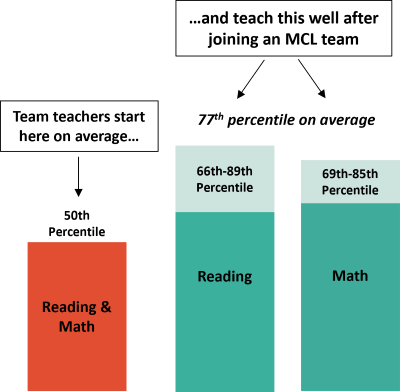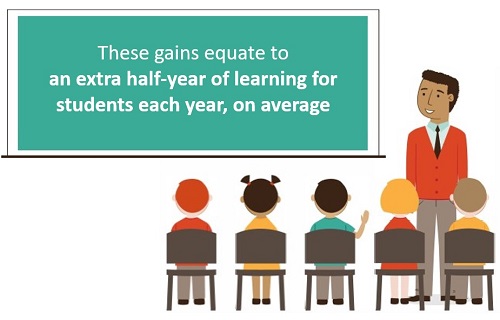Research Shows Results
Opportunity Culture® teams lead to strong student learning gains, research shows
Third-party studies have found that, on average, teachers who joined Multi-Classroom Leader® teams in schools using Opportunity Culture® models moved from producing 50th percentile student learning growth to 77th percentile student learning growth in both reading and math.
- A 2018 study looked at implementation in three early Opportunity Culture® districts
- A 2021 study looked at a Texas district’s outcomes during the 2020–21 pandemic year.
In the Texas study, the researchers highlighted how positive the results were for English language learners and students considered socioeconomically at risk—particularly notable during a pandemic.


When we apply the method of Stanford researchers* to these results to convert the data into years of learning, we see that they equate to an extra half-year of learning for students each year, on average—when an educator in the Multi-Classroom Leader® role with prior high growth leads the team. Some MCL™ teams in these studies had teachers in the Team Reach Teacher™ role, as well.
And in the Texas study, the nearly 2,000 English learners taught by these teams had even larger reading gains—again using the Stanford researchers’ method, that meant an extra 1.3 years of learning compared with other English learners.
Averaging the two studies, the extra learning gains that students onsuch teams make each year would have more than made up for Covid-related learning loss or “unfinished learning,” (as estimated by McKinsey & Company for students nationally from March 2020–May 2021). And in non-Covid years, students would make far more learning growth than they otherwise do, on average.
The Texas study looked at outcomes in the Ector County Independent School District; the 2018 study from Brookings and AIR for the CALDER Center looked at implementation in three early Opportunity Culture® districts.
For more about the two studies, see below; see also our Data Dashboard.
The Opportunity Culture® initiative has been recognized by numerous policy leaders as an effective strategy to address staffing shortages and Covid recovery.
As districts and charter management organizations struggle to cope with worsening staff shortages and pandemic-related student learning concerns, education research groups, advocacy organizations, and state and federal offices have suggested Opportunity Culture® models as one strategy to address these challenges.
Educators express strong satisfaction with their roles.
In early 2023, teachers and staff in Opportunity Culture® roles across the country answered a series of questions about their schools and their jobs. The survey results showed that 97% of teachers in Multi-Classroom Leader® roles and 87% of all staff on MCL™ teams would like the Opportunity Culture® initiative to continue in their schools. In countless interviews, educators have expressed how much they like their roles and what a positive impact these models have had on teacher recruitment and retention and on student achievement.
About the Studies
Texas Study
In the Texas study of Ector County, the district asked Texas Tech researchers Alexander Wiseman, Jacob Kirksey, and Jessica Gottlieb to conduct an independent review of its first eight schools using Opportunity Culture® roles beginning in 2020–21 with 27 educators in MCL™ roles. In those first schools, 72% of students—7,121 out of 9,928 students at the schools—were reached by an MCL™ teaching team.
The researchers showed that Ector County ISD (ECISD) students with Opportunity Culture® teachers achieved higher reading and math achievement at all grade levels, compared with ECISD students who did not yet have such teachers. They reported effect sizes of .20 standard deviations in reading and about .07 standard deviations in math.
In the study, the nearly 2,000 English learners taught by Opportunity Culture® teams had even larger reading gains—again using the Stanford researchers’ method, that meant an extra 1.3 years of learning compared with other English learners.
The Texas Tech researchers also presented a positive qualitative analysis of the district’s implementation. They shared quotes they heard consistently from teachers who appreciated the extensive support they received from their team leaders, and from the leaders, who highlighted the value of their role compared to typical specialist or facilitator roles, and in keeping them working directly with students while leading adults.
AIR-Brookings Study
In the 2018 AIR-Brookings evaluation, students of teachers who served on MCL™ teams showed sizable, statistically significant academic gains. The team teachers were, on average, at the 50th percentile in the student learning gains they produced before joining a team. After joining the teams, they produced learning gains equivalent to those of teachers in the 75th to 85th percentiles in math, and, in the six of seven models with statistically significant results, from the 66th to 72nd percentiles in reading.
The effects appeared to be both direct—with performance improving for individual students in these team leaders’ classrooms —and indirect, with whole schools’ growth rising when the team leaders begin leading in even part of a school. The study compared schools that had Opportunity Culture® classrooms with schools that had none, as well as before-and-after results for schools that have implemented Opportunity Culture® models.
The study, by Ben Backes of the American Institutes for Research and Michael Hansen of the Brookings Institution, covered about 15,000 students and 300 teachers. Three-quarters of schools using Opportunity Culture® models in these districts were eligible for Title I funds in 2015–16. Researchers controlled for factors including student background and prior performance.
*In this method, 0.25 standard deviations = 1 year of learning. See: Hanushek, E., Peterson, P., & Woessmann, L. (2012, Fall). Is the U.S. Catching Up? International and State Trends in Student Achievement. Education Next. Retrieved from http://hanushek.stanford.edu/sites/default/files/publications/Hanushek%2BPeterson%2BWoessmann%202012%20EdNext%2012%284%29.pdf.
Using the method, we see that converting the data into years of learning equated to an extra 0.2 to 0.8 years of learning in reading and an extra 0.3 to 0.7 years of learning in math.
The Opportunity Culture® initiative meets ESSA requirements for an evidence-based intervention for schools in need of improvement.
